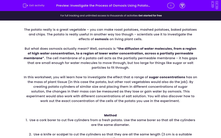The potato really is a great vegetable – you can make roast potatoes, mashed potatoes, baked potatoes and chips. The potato is really useful in another way too though - scientists use it to investigate the effects of osmosis on living plant cells.
But what does osmosis actually mean? Well, osmosis is “the diffusion of water molecules, from a region of high water concentration, to a region of lower water concentration, across a partially permeable membrane”. The cell membrane of a potato cell acts as the partially permeable membrane - it has gaps that are small enough for water molecules to move through, but too large for things like sugar or salt particles to fit through.
In this worksheet, you will learn how to investigate the effect that a range of sugar concentrations has on the mass of plant tissue (in this case the potato, but other root vegetables would also do the job). By creating potato cylinders of similar size and placing them in different concentrations of sugar solution, the changes in their mass can be measured as they lose or gain water by osmosis. This experiment would also work with different concentrations of salt solution. You will also discover how to work out the exact concentration of the cells of the potato you use in the experiment.
Method
1. Use a cork borer to cut five cylinders from a fresh potato. Use the same borer so that all the cylinders are the same diameter.
2. Use a knife or scalpel to cut the cylinders so that they are all the same length (3 cm is a suitable length).
3. Prepare a range of sugar solutions. For example, the concentrations 0.25 mol dm-3, 0.5 mol dm-3, 0.75 mol dm-3 and 1.0 mol dm-3.
4. Set up four boiling tubes containing one of each of these solutions (label each tube with the correct concentration using a waterproof pen). Also, set up a control with distilled water (sugar concentration 0.0 mol dm-3) .
5. Now record the initial mass of each potato cylinder using a balance, before placing one in each boiling tube. Make sure you note down the correct mass of each potato next to the correct concentration in the results table (you do not want to mix up the cylinders, as the initial mass of each one will be slightly different).
6. Leave the potato cylinders in their sugar solutions for a set amount of time, for example 24 hours.
7. Take each cylinder out of the boiling tube and blot it dry with a paper towel (this removes any water before measuring its final mass).
8. Measure the new mass of each cylinder and record the result in your table. You should find that the cylinders will decrease or increase in mass depending on whether they have lost or gained water by osmosis.
Analysing the results
Example:
Say the concentration of cell sap in your potato is exactly 0.6 mol dm-3.
In the 0.25 mol dm-3 solution, the sugar concentration of the potato is higher than in the solution - this means that there are more sugar particles in the cell sap of the potato cells compared to the solution outside. Water molecules will therefore move into the potato by osmosis ( the water moves in from high water levels to lower water levels in order to even out the two concentrations). The mass of the cylinder will increase as a result.
In the 0.75 mol dm-3 solution, there are more sugar particles in the surrounding solution and so the sugar concentration of the potato is now lower (remember 0.6 mol dm-3). Water will move out of the potato by osmosis into the sugar solution (water moves out to dilute the surrounding solution), so the mass of the cylinder will become less.
The initial masses of the potato cylinders will all be different, so it is more accurate to calculate the percentage change in mass of each cylinder rather than simply the change in mass. The percentage change will be positive if the cylinders gained mass but negative if they lost mass. This can be calculated using the equation below:
Percentage change in mass = ((final mass - initial mass) ÷ initial mass) x 100
Example 1:
The potato in 0.25 mol dm-3 had an initial mass of 0.42 g and a final mass of 0.48 g
Percentage change in mass (%) = (( 0.48 g – 0.42 g) ÷ 0.42) x 100
= ( 0.06 ÷ 0.42) x 100 = 0.1428 x 100
Percentage change in mass (%) = 14.28% or 14.3% (to 1 decimal place)
Example 2:
The potato in 0.75 mol dm-3 had an initial mass of 0.40 g and a final mass of 0.32 g
Percentage change in mass (%) = (( 0.32 g – 0.40 g) ÷ 0.40) x 100
= (-0.08 ÷ 0.40) x 100 = -0.2 x 100
Percentage change in mass (%) = -20.0%
Finally, plot your results for percentage change in mass against sugar concentration on a graph and draw a line of best fit. This is not only a nice, clear way to show your results, but it also allows you to find the sugar concentration at which your best fit line crosses the x axis (at 0% percentage change in mass). This will tell you the concentration of the cell sap in your potato cells, amazing! If a potato cylinder had been placed in a sugar solution of this concentration, there would be no overall movement of water. The potato would not lose or gain any mass (0% change) as the concentration of the sugar solution and the potato cell sap would be identical.
Now let's have a go at some questions.




.PNG)
.PNG)
.PNG)
.PNG)




